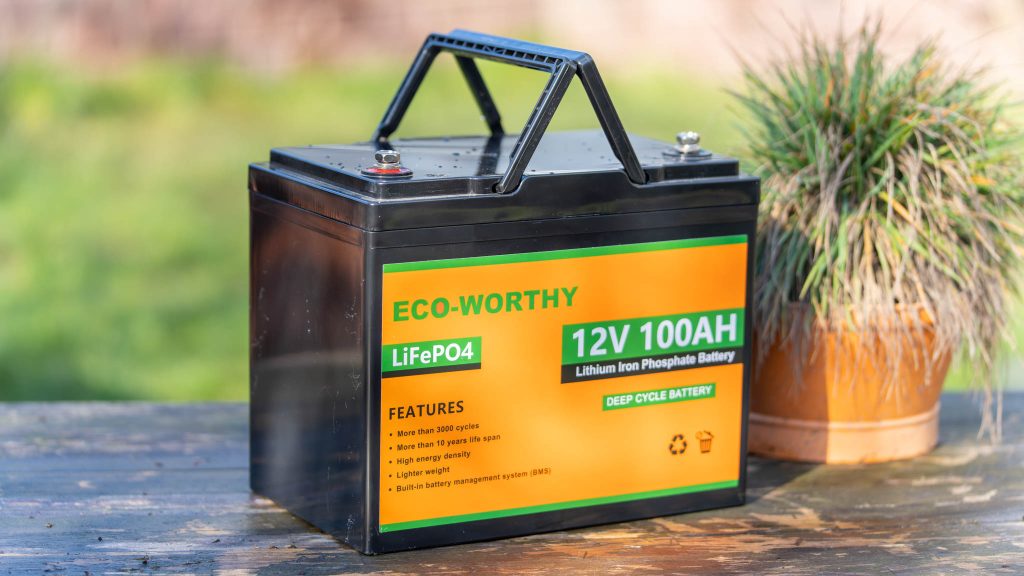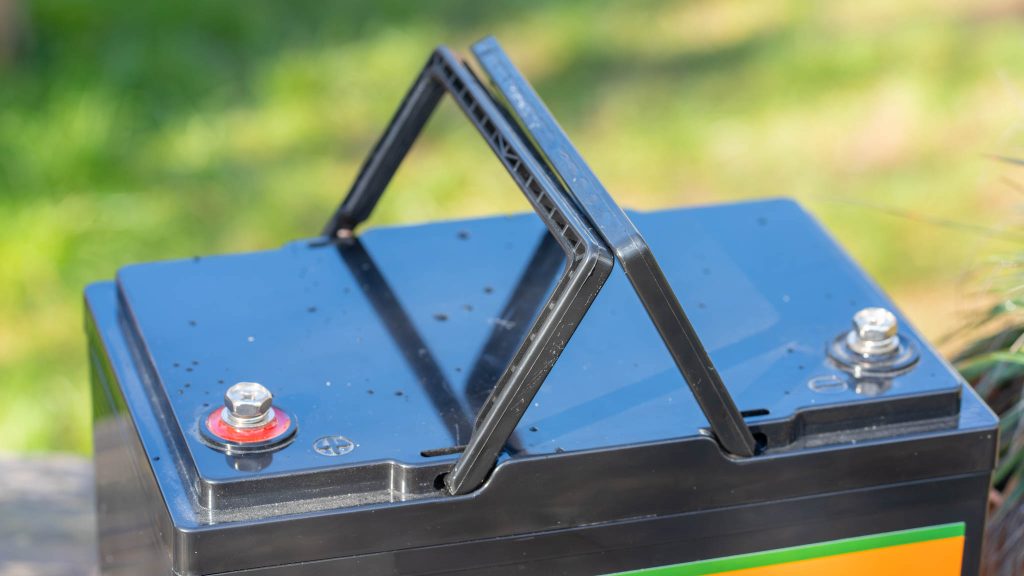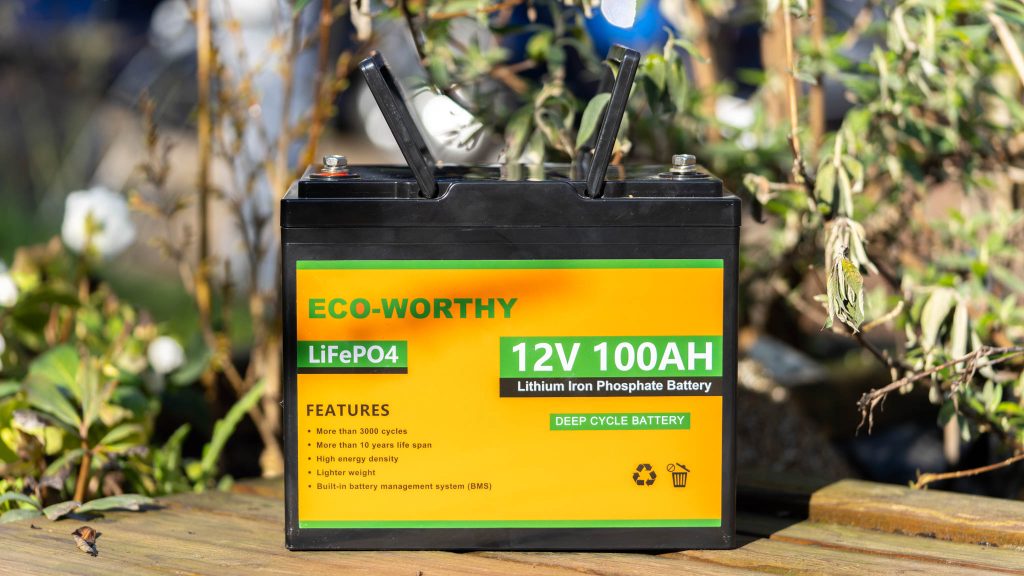If you are looking for a buffer storage for a solar system, then you should choose a LiFePO4 battery. These are available in many price ranges.
The cheapest LiFePO4 batteries are from ECO-Worthy. You can get a 100Ah battery for under 400€. This is a very good price!
But what does it look like in practice? Does the battery really offer 100Ah? How well does it age? This is exactly the question I would like to answer in this test.
I bought the ECO-Worthy LiFePO4 12V 100Ah battery about a year ago and took measurements when I received it and now also after a year. Let’s see if there was a loss of capacity and if so, how high it was.
The ECO-Worthy LiFePO4 12V 100Ah battery in the test
You might not notice it right away, but the ECO-Worthy LiFePO4 battery is quite small for its capacity of 100Ah!
The battery measures 260 x 168 x 209 mm, making it one of the smallest 100Ah LiFePO4 batteries. This is often “suspicious”, but in this case there is another explanation.
Simply M8 screws are used as connection terminals. Nothing special, but it works.
Performance values
- ECO-Worthy LiFePO4 12V 100Ah battery pack
- 12,8V voltage
- 14.5V maximum voltage
- 100A maximum discharge current
- 50A maximum charge current
- Temperature range (discharging) -20-55 degrees
- Temperature range (charging) 0-55 degrees
- 3000 cycles
We have here a quite classic 100Ah battery. So not only does it have 100Ah, but it can also be discharged at a maximum of 100A, 1C. On the charging side we have a maximum of 50A, 0.5C.
These data are not only determined by the battery cells but primarily by the BMS that is installed here.
Why a LiFePO4 battery?
But why should you buy a LiFePO4 battery? LiFePO4 has some advantages compared to classic lead gel batteries and also lithium ion batteries!
Extremely high cycle stability (here 3000+ cycles)
Very high safety
If you load a lead gel battery with low cycles, it will break very quickly! Here we are talking about well under 100 cycles, in my experience. Even with Lithium Ion batteries we “only” get 300-1000 cycles.
LiFePO4 batteries, on the other hand, reach 2000-4000 cycles! ECO-Worthy advertises 3000 cycles. This gives the batteries a much longer life expectancy and also massively improves the price/performance ratio.
Also, LiFePO4 cannot go through thermal runaway or in an extreme situation, short-circuit and the BMS fails, the battery would steam up etc. but would not burst into a big sea of flames as lithium ion batteries can do.
However, LiFePO4 batteries also have disadvantages. For example, LiFePO4 batteries are larger and heavier than lithium ion batteries, with the same capacity!
In addition, LiFePO4 batteries must not be charged at temperatures below 0 degrees! Unfortunately, the ECO-Worthy does not have a cut-off! You must therefore manually ensure that you do not charge at below 0 degrees or use a charge controller that does this.
How high is the capacity of the ECO-Worthy LiFePO4 12V 100Ah battery really?
To test the capacity of the ECO-Worthy LiFePO4 12V 100Ah battery, I first fully charged it (to approx. 14.6V) and then discharged it with an electronic load.
This was done at different power levels, 5A, 10A and 20A. Let’s take a look at the measured values.
| Ah | Wh | |
| 5A | 102,1 | 1318 |
| 10A | 101,92 | 1315,5 |
| 20A | 101,43 | 1289,3 |
Yes, the ECO-Worthy LiFePO4 12V 100Ah can maintain its capacity when new! In fact, it can even slightly exceed the capacity specification with up to 102Ah / 1318 Wh. Great!
The capacity after one year
The measured values from above are from my original article on techtest. Since then, however, I have used the battery in a DIY solar system (OffGrid).
Unfortunately, I don’t have exact cycle values here! But I estimate that the battery has about 200-300 cycles. Theoretically, that’s not much, considering that the manufacturer advertises 3000 cycles.
Let’s take a look at the values after 1 year and approx. 200-300 cycles.
We definitely see a slight loss of capacity! The capacity dropped from 102.1Ah to 97.01Ah.
Is this too great a loss of capacity? Difficult to assess. It is perhaps a little higher than I would have expected, but not problematically high. It is to be expected that the capacity drops a little faster at the beginning of the battery’s life, then stabilises and then drops again a little more at the end.
Therefore, I would consider 97.01Ah to be OK after one year of use as a buffer storage. It will be exciting to see how the capacity changes in year 2. I expect it to fall less sharply here.
Conclusion
I can’t really say anything negative about the ECO-Worthy LiFePO4 12V 100Ah battery. Do I think this is the best 100 Ah battery? No, there are models that are better, see my comparison of 4x 100Ah LiFePO4 batteries.
But at a price of €399, I can’t complain. When new, the capacity specification of 100 Ah is even slightly exceeded with up to 102.1 Ah, and even after a year of daily use as a buffer storage unit, the capacity of 97.01 Ah remains within a decent range.
The only thing to note here is the lack of an undertemperature cut-off.
- [Lithiumbatterie mit geringem Gewicht]: Die...
- [BMS mit Low Temperaturschutz enthalten]:...
- [Lithium-Eisen-Batterie] Die ECO-WORTHY...
- [Breite Anwendung]: Die LiFePo4 batterie 12V...
- [Kapazitätserweiterung] Die Lithiumbatterie...
Apart from that, however, I have nothing to complain about at this low price. You can buy the ECO-Worthy LiFePO4 12V 100Ah battery without any worries.







